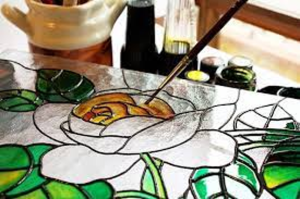Glass painting is a mesmerizing art form that transforms ordinary glass surfaces into vibrant, expressive masterpieces. Whether you’re a budding artist or a seasoned creator, this guide will illuminate the techniques, tools, and troubleshooting tips necessary to navigate the enchanting realm of glass paints.

Glass Paints: An Overview
Glass paints, specifically formulated for adhesion to glass surfaces, come in various types such as transparent, opaque, and specialized paints like enamel or stained glass paints. These paints, often based on water or solvent, offer a spectrum of colors and textures to unleash your creativity on windows, vases, or glassware.
Types of Glass Paints
- Transparent Glass Paints: Ideal for creating stained glass effects or vibrant translucent designs.
- Opaque Glass Paints: Provide solid coverage and are suitable for detailed artwork and blocking light.
- Enamel Glass Paints: Known for their durability and glossy finish, perfect for decorative glassware.
Step-by-Step Guide to Glass Painting
Step 1: Preparation
- Surface Cleaning: Ensure the glass surface is clean and free from any dust or grease.
- Outline Design: Use markers or outlines to guide your painting, especially for intricate designs.
Step 2: Painting Technique
- Brush Selection: Choose brushes suitable for the type of paint and the intricacy of your design.
- Layering Colors: Apply thin layers of paint, allowing each layer to dry before adding another for depth and vibrancy.
- Blending and Mixing: Experiment with blending colors directly on the glass for unique effects.
Step 3: Curing and Finishing
- Drying Time: Allow ample time for the paint to dry and cure based on the manufacturer’s instructions.
- Baking or Curing: Some paints may require baking or curing in an oven for durability and permanence.
- Sealing the Artwork: Use a sealant to protect the painted surface from scratches or fading.
Troubleshooting Common Issues
- Paint Peeling or Chipping: Ensure proper surface preparation and use compatible paints for glass.
- Uneven Coverage: Apply thin, even coats of paint, avoiding excessive buildup.
- Color Bleeding: Use masking techniques or specialized tools to prevent colors from bleeding into each other.
Tips for Success
- Practice on Test Surfaces: Experiment on spare glass pieces to get comfortable with the paints and techniques.
- Clean Brushes Thoroughly: Clean brushes promptly after use to maintain their quality and prevent paint buildup.
- Patience and Precision: Take your time and work meticulously for stunning, professional-looking results.
Conclusion
Glass painting is an enchanting fusion of creativity and precision, allowing artists to breathe life into transparent canvases. Armed with this comprehensive guide and a passion for artistic expression, you’re poised to create captivating works that elevate the beauty of glass.
Explore Our Glass Paint Collection
Discover a diverse array of premium glass paints at ArtGlassSupplies.com’s Glass Paints page. Unleash your creativity and embellish glass surfaces with our high-quality paints designed to inspire and endure.

